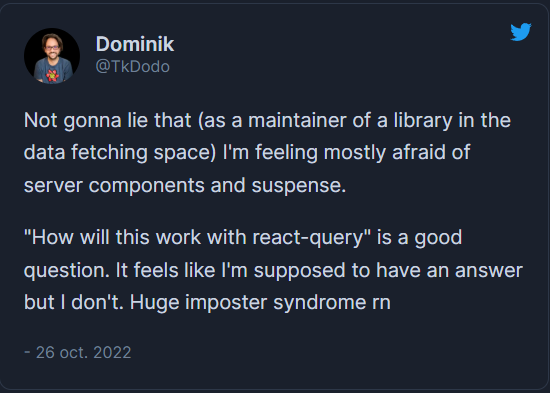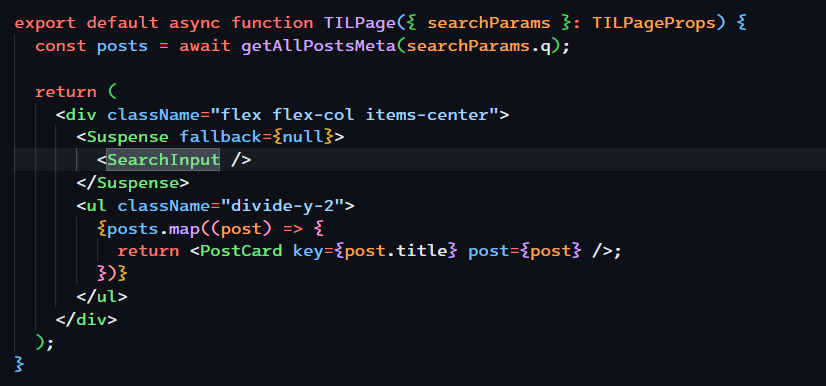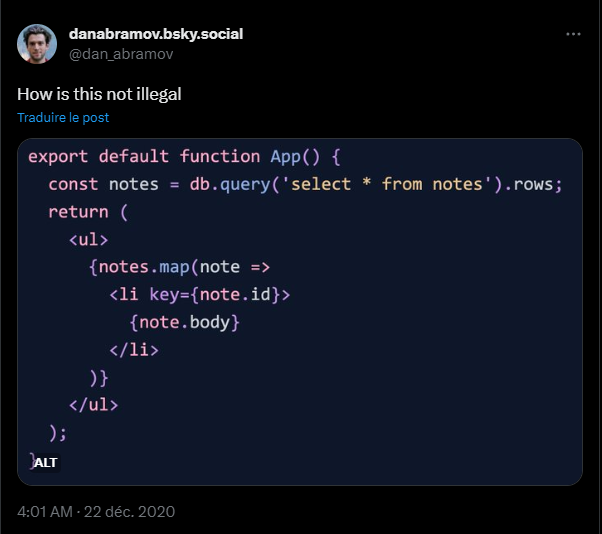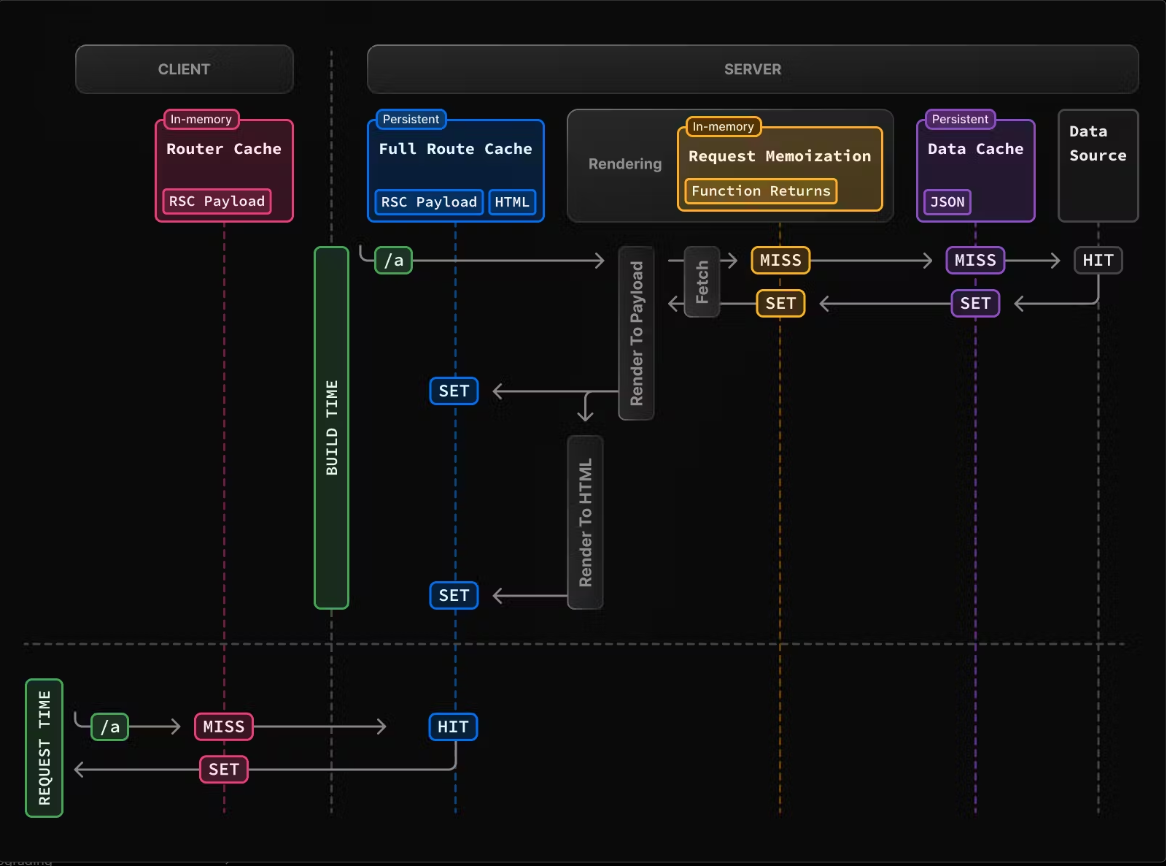The Future of React
I switched to React Server Components
From Remix to Nextjs
In my post What the stack, I mentioned that Remix was part of my stack because I thought Next.js was in a weird state. On May 4th, Vercel announced that their new "app Router" is now stable, cohabiting with the old one now named "page router." It still seems a bit strange, but it's now stable. I thought it was time to see what a great team like Vercel did with this new iteration of Next.js.
I am not sure to understand...
While it was still in beta and even after it was declared stable, I spent a lot of time reading the new router documentation, following Dan Abramov's Twitter threads, trying to understand the new concepts this new router introduced, etc. However, I couldn't wrap my head around it. Every time I thought I understood it, experimenting with it proved me wrong multiple times. It seems I wasn't alone, as even some of the greatest engineers seemed confused as well.

Ok, I guess I get what RSC brings now
After a lot of trial and error and confusion, I thought that the best way to grasp it was to create something with it. I decided to rewrite my personal website using it, as I also wanted to switch from Fly.io to Vercel. The homepage was basically copy and paste, but the "Today I Learned" page was different. Thanks to React Server Components, which are asynchronous components running only on the server, I could now place my server code inside my components.

This means that you can to that:

It was one of the tweet that made me understand the mental model behind RSC.
What it implies, and as Dan Abramov says:

I mean, if you have no interest to share your API, why would you write it ? Just fetch what you want directly where you need !
However, there's no such thing as a free lunch. While you can perform asynchronous tasks in RSC, what you can't do is define interactivity. No useState, no useEffect, no event handlings are allowed in those server components. You also can't use a library that would provide it. For interactivity, you have to create a separate file that includes the mention "use client" for Next.js to understand that it's a client-side file.
"use client";
import { useState } from "react";
function Counter() {
const [count, setCount] = useState(0);
return (
<div>
<p>Count: {count}</p>
<button onClick={() => setCount((c) => c + 1)}>Increment</button>
</div>
);
}
So how to compose between those two worlds ? Firstly, you can use a client component in a server component with no problem, but you can't do the opposite. The only way you can do that is by passing Server Components as props to client comoponents.
Here is an example from the Nextjs doc
client-component.js
'use client'
import { useState } from 'react'
export default function ClientComponent({
children,
}: {
children: React.ReactNode
}) {
const [count, setCount] = useState(0)
return (
<>
<button onClick={() => setCount(count + 1)}>{count}</button>
{children}
</>
)
}
server-component.js
// This pattern works:
// You can pass a Server Component as a child or prop of a
// Client Component.
import ClientComponent from './client-component'
import ServerComponent from './server-component'
// Pages in Next.js are Server Components by default
export default function Page() {
return (
<ClientComponent>
<ServerComponent />
</ClientComponent>
)
}
Since it was already difficult for me to wrap my head around all these new concepts and ways of thinking, I am definitely not the best person to explain it. Before making more mistakes while explaining it, I will let you read the Nextjs doc documentation, check out Dan Abramov tweets, and watch all the YouTube videos made by tech influencers.
What about App router ?
In the previous section, I tried to (poorly) explain what RSC are and how they could change the way we build web apps. However, RSC is something new in the React library. What Next.js did is create an environment for us to use RSC in the best way possible. This environment is called the App Router. Firstly, I've never worked on anything big with Next.js, but I wasn't a big fan of file-based routing, and I think I'm even less of one with the app router. There are a lot of file conventions, and for me, it seems less flexible than a code-based router.
Something I liked even less is how caching is handled. Maybe I'm not comfortable enough with it, but what a mess... I spent so much time trying to understand why my request was not cached or how to invalidate what I wanted. At the time I first played with it, the documentation didn't help me much, and I saw others on YouTube and Twitter complaining about it. More recently, they added this diagram to explain how it works:

Seriously ? This thing is too complicated for me to keep in mind at all time.
Conclusion
To conclude, I believe that RSC is a great addition to React, and I am really excited to see what talented developers will achieve with it. As for what Next.js has done with it, I am not yet convinced, at least for now. It is always challenging to be the first to try something new, and I am confident that the app router will undergo significant evolution in the future. Will I recommend Next.js app router at my workplace? I think not. Next.js with the page router? Perhaps. I mainly work on SaaS projects that don't require SEO optimization, and where initial load time is not a major concern. I understand that for e-commerce, shaving off a few milliseconds from the initial load time by sending less JavaScript to the client is significant, but it doesn't hold the same weight for me.
I have been working with React for five years now, and I believe I understand it well enough. However, comprehending RSC was quite challenging for me. Even Dan Abramov had a hard time explaining it to the community. It also took some time for bleeding-edge React evangelists and tech influencers to fully grasp it (https://www.youtube.com/watch?v=fmztj8hywlI). How junior developers will manage it? I'm uncertain. It's possible that our experience with React over the years has limited our ability to think differently, and in that case, they might actually be better suited to understand it. Alternatively, it could simply be too complex at the moment.
Besides, there is also such good libraries on SPA side ! I am obviously thinking about React Query, but also trpc. Tanstack/router is now in beta but already looks amazing...
I think I am good in my SPA world right now !
Go check the new source code of my website on Github if you want to see what a simple website with the App router looks like. I also used Server Actions for comment creation.
No comments yet.
Add a comment
You must be logged in to comment. Click here to sign in.